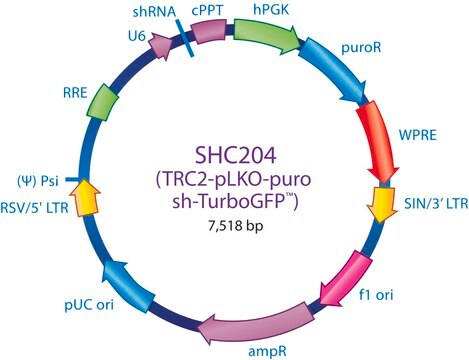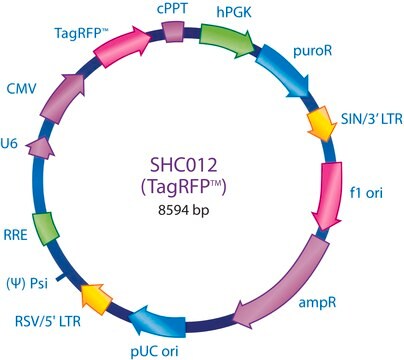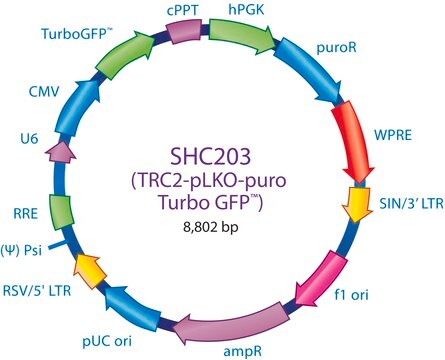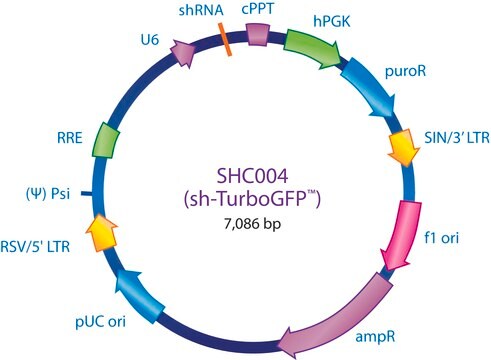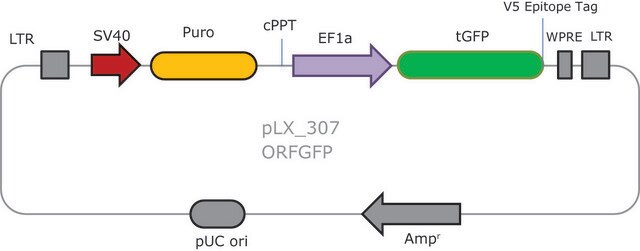SHC005
MISSION® eGFP shRNA Control Vector
shRNA sequence targeting eGFP
Sinónimos:
MISSION® Control Vectors
Iniciar sesiónpara Ver la Fijación de precios por contrato y de la organización
About This Item
product line
MISSION®
concentration
500 ng/μL in TE buffer; DNA (10μg of plasmid DNA)
shipped in
dry ice
storage temp.
−20°C
¿Está buscando productos similares? Visita Guía de comparación de productos
Categorías relacionadas
General description
The MISSION® eGFP shRNA Control Vector is a 7,091 base pair lentivirus plasmid vector that contains an shRNA sequence targeting eGFP (GenBank Accession No. pEGFP U55761). The eGFP shRNA Control Vector is useful as a positive knockdown control in experiments using cell lines expressing eGFP.
Ampicillin and puromycin antibiotic resistance genes provide selection in bacterial or mammalian cells respectively. In addition, self-inactivating replication incompetent viral particles can be produced in packaging cells (HEK293T) by co-transfection with compatible packaging plasmids, MISSION® Lentiviral Packaging Mix (Prod. No. SHP001). The eGFP shRNA Control Vector is provided as 10 μg of plasmid DNA in Tris-EDTA (TE) buffer at a concentration of 500 ng/μl.
Ampicillin and puromycin antibiotic resistance genes provide selection in bacterial or mammalian cells respectively. In addition, self-inactivating replication incompetent viral particles can be produced in packaging cells (HEK293T) by co-transfection with compatible packaging plasmids, MISSION® Lentiviral Packaging Mix (Prod. No. SHP001). The eGFP shRNA Control Vector is provided as 10 μg of plasmid DNA in Tris-EDTA (TE) buffer at a concentration of 500 ng/μl.
Application
To see more application data, protocols, vector maps visit sigma.com/shrna.
Legal Information
Use of this product is subject to one or more license agreements. For details, please see http://sigmaaldrich.com/missionlicense.
MISSION is a registered trademark of Merck KGaA, Darmstadt, Germany
Storage Class
12 - Non Combustible Liquids
wgk_germany
WGK 1
flash_point_f
Not applicable
flash_point_c
Not applicable
Certificados de análisis (COA)
Busque Certificados de análisis (COA) introduciendo el número de lote del producto. Los números de lote se encuentran en la etiqueta del producto después de las palabras «Lot» o «Batch»
¿Ya tiene este producto?
Encuentre la documentación para los productos que ha comprado recientemente en la Biblioteca de documentos.
Los clientes también vieron
Myoferlin regulates cellular lipid metabolism and promotes metastases in triple-negative breast cancer.
Blomme A
Oncogene, 36(15), 2116-2130 (2017)
Nhu Nguyen et al.
Oncotarget, 7(52), 86300-86312 (2016-11-20)
SETBP1 missense mutations have been frequently identified in multiple myeloid neoplasms; however, their oncogenic potential remains unclear. Here we show that expression of Setbp1 mutants carrying two such mutations in mouse bone marrow progenitors efficiently induced development of acute myeloid
Alexandra Veloso et al.
Cell death & disease, 10(7), 512-512 (2019-07-06)
Muscle formation is controlled by a number of key myogenic transcriptional regulators that govern stage-specific gene expression programs and act as terminal effectors of intracellular signaling pathways. To date, the role of phosphatases in the signaling cascades instructing muscle development
Huizhi Wang et al.
Oncogenesis, 9(8), 76-76 (2020-08-28)
Methyl-CpG-binding protein 2 (MeCP2) has been characterized as an oncogene in several types of cancer. However, its precise role in pancreatic ductal adenocarcinoma (PDAC) remains unclear. Hence, this study aimed to evaluate the potential role of MeCP2 in pancreatic cancer
Arnaud Blomme et al.
Oncotarget, 7(50), 83669-83683 (2016-11-16)
Exosomes are communication mediators participating in the intercellular exchange of proteins, metabolites and nucleic acids. Recent studies have demonstrated that exosomes are characterized by a unique proteomic composition that is distinct from the cellular one. The mechanisms responsible for determining
Nuestro equipo de científicos tiene experiencia en todas las áreas de investigación: Ciencias de la vida, Ciencia de los materiales, Síntesis química, Cromatografía, Analítica y muchas otras.
Póngase en contacto con el Servicio técnico